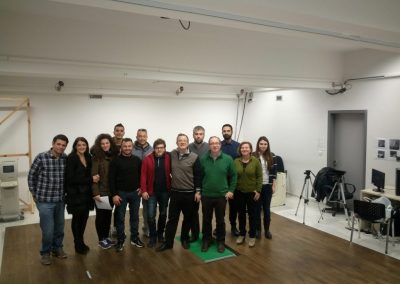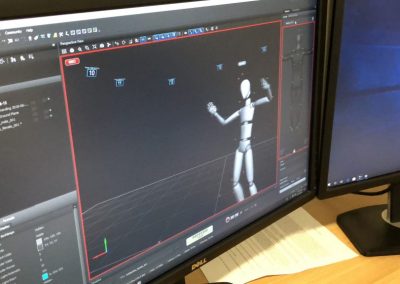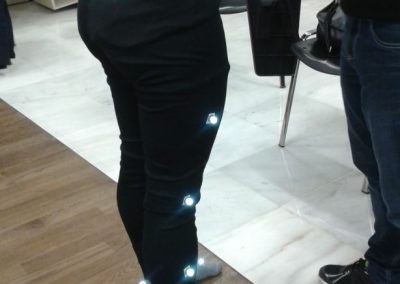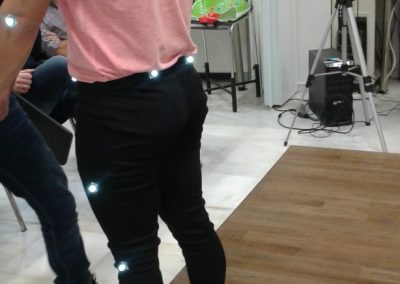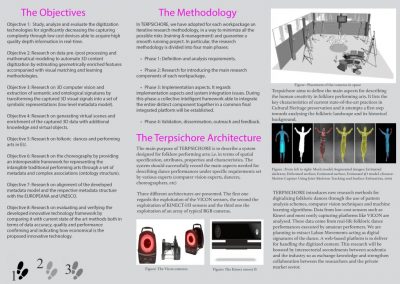Terpsichore
Transforming Intangible Folkloric Performing Arts into Tangible Choreographic Digital Objects

Terpsichore Dataset is available under appointment.
For more details please contact us
This project has received funding from the European Union’s Horizon 2020 research and innovation programm under grant agreement No 691218. (https://cordis.europa.eu/project/id/691218)
Intangible Cultural Heritage (ICH) content means “”the practices, representations, expressions, knowledge, skills – as well as the instruments, objects, artefacts and cultural spaces associated therewith””. Although, ICH content, especially traditional folklore performing arts, is commonly deemed worthy of preservation by UNESCO (Convention for the Safeguarding of ICH) and the EU Treaty, most of the current research efforts are on the focus is on tangible cultural assets, while the ICH content has been overlooked. The primary difficulty stems by the complex structure of ICH, its dynamic nature, the interaction among the objects and the environment, as well as emotional elements (e.g., the way of expression and dancers’ style). TERPSICHORE aims to study, analyse, design, research, train, implement and validate an innovative framework for affordable digitization, modelling, archiving, e-preservation and presentation of ICH content related to folk dances, in a wide range of users (dance professionals, dance teachers, creative industries and general public). The project targets at integrating the latest innovative results of photogrammetry, computer vision, semantic technologies, time evolved modeling, combined with the story telling and folklore choreography. An important output of the project will be a Web based cultural server/viewer with the purpose to allow user’s interaction, visualization, interface with existing cultural libraries (EUROPEANA) and enrichment functionalities to result in virtual surrogates and media application scenarios that release the potential economic impact of the ICH. The final product will support a set of services such as virtual/augmented reality, social media, interactive maps, presentation and learning of European Folk dances with tremendous impact on the European society, culture and tourism”
OBJECTIVES
Objective 1: Study, analyze and evaluate the digitization technologies for significantly decreasing the capturing complexity by introducing low cost devices able to acquire high quality depth information in real-time and compare such smart sensors with imaging technologies (enhanced through the use of computer vision tools, data processing and 3D modeling) in order to result in accurate virtual reconstructions of moving, complex (non-rigid) objects which dynamically interact with each other and with the environment.
Objective 2: Research on data pre-/post processing and mathematical modeling with the purpose of automating the 3D content digitization by estimating geometrically enriched features accompanied with visual matching and learning methodologies. Such tools enable the association of different multi-view captured images in a common virtual interface, reducing the digitization complexity, increasing automation, data quality and accuracy.
Objective 3: Research on 3D computer vision and extraction of semantic and ontological signatures by transforming the captured 3D visual signals into a set of symbolic representations (low level metadata model). In this technological direction, the project will investigate computational geometry methodologies for modeling human movement by estimating the trajectory of Laban movement analysis points, as well as methods for measuring, in a semi-automatic way, human creativity, that is the way of expression (mainly the style of a performance).
Objective 4: Research on generating virtual scenes and enrichment of the captured 3D data with additional knowledge and virtual objects. The project will investigate advanced methods in the area of 3D/4D rendering of planet-size geographic and/or architectural environments, even under a perceptualized way, enriched with animation (e.g. characters) using a virtual globe approach that will offer a unique, homogeneous and intuitive visual interface to access any cultural knowledge in its geographic context.
Objective 5: Research on selected Folk music, -songs, -instruments, number and sex of persons (male, female, young or old dancers) and -uniforms of EU Folklore performing arts (executed by professional adult dancers only). The project will explore the conditions and all the parameters which are related with the above-mentioned topics, such as the geographic area and the region, the environmental conditions e.g. +Climate, the history and the time period of the year and conditions on which this performance is taking place (wedding, national celebration, etc).
Objective 6: Research on the choreography by providing an interoperable framework for representing the intangible traditional performing arts through a set of metadata and complex associations (ontology structure). The proposed high level metadata model and the respective structure will be used to encode the overall human creativity, which is a very significant aspect for the protection and preservation of the traditional folklore performances.
Objective 7: Research on alignment of the developed metadata model and the respective metadata structure with the EUROPEANA and UNESCO (the Memory of the World) activities by following (or even adapting) existing specifications used for representing and encoding tangible cultural resources. In this way, the ground-breaking project allows easy interconnection with existing cultural libraries, permitting easy manipulation, enrichment, use and re-use of the captured traditional performances with other tangible or intangible content.
Objective 8: Research on evaluating and verifying the developed innovative technology framework by comparing it with current state of the art methods both in terms of data accuracy, quality and performance confirming and indicating how economical is the proposed innovative technology (through the incorporation of advanced methods in computer vision, 3D modeling and virtual reconstruction) compared with current expensive digitization and available on the market general documentation methods.

METHODOLOGY
The originality of this work is two-fold:
1. On a technical point of view, it will confer to TERPSICHORE the unique capability of visualising animations, including virtual characters, within a highly detailed and planet size 3D geographic environment based on the results of the V-City project.
2. On a user point of view, TERPSICHORE browser will represent the first unified visual interface to access any geo-localized cultural information available on the planet including animations in their geographic context.
In other words, TERPSICHORE offers a new progress beyond the state of the art in the field of geographic and cultural information visualisation. V-City has been the first system ever capable of visualising complete built environments with unprecedented details, including indoors. TERPSICHORE will add cultural life to this system.
In TERPSICHORE, we have adopted for each workpackage an iterative research methodology, in a way to minimize all the possible risks (training & management) and guarantee a smooth running project. In particular, the research methodology is divided into four main phases (see Figure 2)
- Phase 1: Definition-and analysis requirements. This will take place at the beginning of each research step. Requirements will be defined in respect to folklore traditional performing arts and in close collaboration with the advisory board for initiating a research roadmap and defining the research framework for each step.
- Phase 2: Research. It is responsible for introducing the main research components of each workpackage. More specifically, it includes identification and exploitation of best available technologies, anticipating a risk and contingency plan in case that the designed or adopted technology is not able to fulfill requirements of Phase 1 and introduce objective benchmarking tools the for evaluation of the research tools.
- Phase 3: Implementation aspects. It regards implementation aspects and system integration issues. During this phase a collective intelligent framework able to integrate the entire distinct component together in a common final integrated platform will be established. All previous results are interlinked together Within this framework, on the one hand previous phases’ and research steps’ outcomes are integrated, and on the other platform’s architecture and research shortcomings are detected and surpassed, to stay aligned with project’s objectives and timeline. TERPSICHORE respects personal data of the professional adult dancers.
- Phase 4: Validation, dissemination, outreach and feedback. Validation will be accomplished using the benchmarking metrics derived from the research phase and the recommendations as well as consultations of the end-users (such as Europeana and the media industrial partners) and the advisory board. Dissemination and outreach activities are designed in a way to ensure maximal impact and contribute to the ERA, by covering the full chain, ranging from research, academia, industry, policy makers and ICH stakeholders to general public and pupils. Throughout the different tasks in each segment of the project, there are inter-relations between different phases, to guarantee that the main research objectives will be addressed and realized to the maximum extend.

